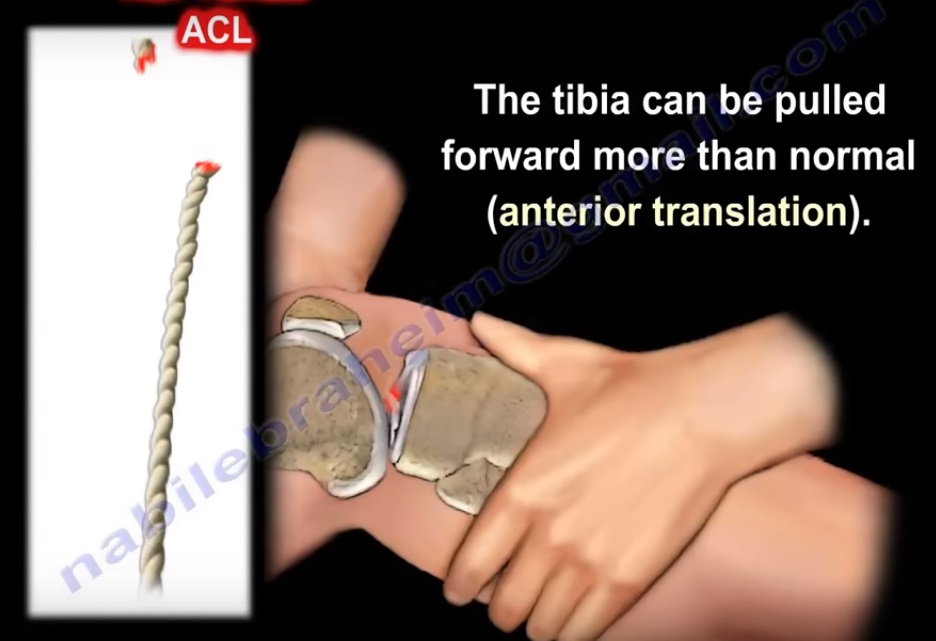Courtesy: Prof Nabil Ebraheim, University of Toledo, Ohio, USA

Lachman’s test is the most sensitive examination test for ACL injury.The anterior cruciate ligament is located in front of the knee.The primary function of the ACL is to resist anterior translation of the tibia relative to the femur and provide some rotational stability to the knee.Rupture of the ACL is a condition commonly seen in sports due to a non-contact pivoting injury. ACL rupture is usually a complete rupture.Speaking about patient evaluation, he/she usually hears or feels a ‘POP’ within the knee.The other features are that of sudden knee pain,a swelling developing within hours and a history of the knee ‘giving away’.The examination is usually difficult and limited by the pain.There is usually haemorrhage within the knee joint (hemarthrosis).If the aspiration of the knee shows hemarthrosis, then there is a 75% chance of a ACL tear or a meniscal injury(lateral meniscus).The Lachman test is the most sensitive and useful test for diagnosing ACL tear in the acute setting.
To perform this test,the patient should be lying supine and completely relaxed.It is important to make sure that the patient’s hip muscles,quadriceps and hamstring muscles are all all relaxed.Bend the knee to about 20-30 degrees. Stabilise the femur with one hand and with the other hand,pull the tibia anteriorly and posteriorly against the femur.With an intact ACL,as the tibia is pulled forward, the examiner should feel an end point. With a ACL rupture,the ACL will be lax and the examination will feel softer with no end point.The tibia can be pulled forward more than normal.Be aware that a PCL tear can cause posterior subluxation of the tibia and give rise to a false positive Lachman’s test.
The ACL injury grades using the Lachman’s test are as follows.Grade 1 means 3-5 mm of translation, grade 2 is 5-10 mm of translation and grade 3 is greater than 10 mm of translation.In addition to assessing the amount of translation of the tibia and the quality of the end point of the Lachman test, it is also important to examine the patellar and quadriceps tendons as the rupture of these tendons can be confused with a ACL rupture.Other tests for diagnosis of a ACL injury are the anterior drawer test which is not as reliable as the Lachman test.
Another test for diagnosis is the Pivot shift test which is done by going from extension to flexion of the knee,and the tibia will be reduced at 20-30 degrees of flexion.The test measures the functional instability of the knee or the “giving away” of the knee.Pivot shift is pathognomonic for a ACL tear and is best demonstrated in the chronic setting.It is a more difficult test than the Lachman test.
Rupture of the ACL causes anterolateral rotatory instability.The tibia moves anterolaterally in extension,however when you flex the knee,the IT band becomes a flexor of the knee.The IT band pulls back and reduces the tibia.Both the Lachman test and the Pivot shift test are associated with 20-30 degrees of knee flexion.The Lachman test starts at 20-30 degrees of knee flexion while with the Pivot shift test,a clunk is heard at 20-30 degrees of knee flexion.So,it seems that 20-30 degrees of knee flexion is important for the testing of the ACL. The diagnosis of ACL rupture is confirmed with an MRI.In addition to an ACL tear,an MRI of the knee joint can show bone bruises or injuries that are consistent with an ACL tear.These injuries are typically located at the middle of the femoral condyle and the posterior part of the tibia laterally.
Leave a Reply